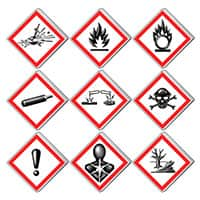OSHA Issues Proposed Rule to Update Hazard Communication Standard
Employers, are your employees exposed to hazardous chemicals in your workplace?
On February 9, 2021, the Occupational Safety & Health Administration (OSHA), published a proposed update to its Hazard Communication Standard (HCS). The update is based on the United Nations Globally Harmonized System of Classification and Labeling of Chemicals (GHS), and is meant to align the standard with other federal agencies and international trading partners through an internationally negotiated approach to hazard communication. More specifically, the proposed update the HCS intends to improve and enhance worker protection through:
- Providing additional clarification of existing regulatory requirements
- Incorporating new hazard classes and categories
- Improving and streamlining precautionary statements
- Facilitating international trade through increased alignment.
OSHA also reports the proposed changes would improve dissemination of hazard information, so employees are more appropriately apprised of exposure to chemical hazards in the workplace. OSHA estimates the proposal would affect 115,758 firms, 152,427 establishments and 1,510,780 employees.
The official version of the lengthy proposed rule in the Federal Register can be found online.
Also, OSHA's Directorate of Standards and Guidance published an informative presentation on the proposed update to the Hazard Communication Standard.
OSHA Hazard Communication Standard Definitions
OSHA's Hazard Communication Standard, originally finalized by OSHA in 1983, is found within 29CFR 1910 General Industry regulations, Subpart Z, Toxic & Hazardous Substances, Section 1910.1200 and is designed to ensure chemical safety in the workplace by requiring that:
- Chemical manufacturers and importers are responsible for providing information about the identities and hazards of chemicals they produce or import.
- All employers with hazardous chemicals in their workplaces are required to have a hazard communication program and provide information and training to employees about their hazards and associated protective measures.
The full OSHA regulatory context can be found online.

OSHA's Hazard Communication Standard was last updated in 2012 and included new GHS requirements and compliance timelines for chemical manufacturers and importers, employers, and employees. Highlights included:
- Harmonized definitions and classifications for physical, health and environmental hazards
- Labels- Specific criteria required for all labels to include pictograms, a signal word, hazard and precautionary statements, the product identifier, and supplier identification.
- Safety Data Sheets that include a 16-section format outlined as follows:
Section 1- Identification includes product identifier; manufacturer or distributor name, address, phone number; emergency phone number; recommended use; restrictions on use.
Section 2- Hazard(s) identification includes all hazards regarding the chemical; required label elements.
Section 3- Composition/information on ingredients includes information on chemical ingredients, trade secret claims.
Section 4- First-aid measures include important symptoms/effects, acute, delayed; required treatment.
Section 5- Fire-fighting measures lists suitable extinguishing techniques, equipment, chemical hazards from fire.
Section 6- Accidental release measures list emergency procedures; protective equipment; proper methods of containment and cleanup.
Section 7- Handling and storage lists precautions for safe handling and storage, including incompatibilities.
Section 8- Exposure controls/personal protection lists OSHA's Permissible Exposure Limits (PELs); ACGIH Threshold Limit Values (TLVs); and any other exposure limit used or recommended by the chemical manufacturer, importer, or employer preparing the SDS where available as well as appropriate engineering controls; personal protective equipment (PPE).
Section 9- Physical and chemical properties lists the chemical's characteristics.
Section 10- Stability and reactivity lists chemical stability and possibility of hazardous reactions.
Section 11-Toxicological information includes routes of exposure; related symptoms, acute and chronic effects; numerical measures of toxicity.
Section 12- Ecological information
Section 13- Disposal considerations
Section 14- Transport information
Section 15- Regulatory information
Section 16- Other information
Hazardous chemicals in the workplace demand strict compliance with all applicable regulations. For more information on OSHA's Hazard Communication Standard, please visit their webpage.
And if you have more HAZCOM questions, be sure to review the FAQ section of the webpage.
To stay up to date on all OSHA standards, register for online compliance training including Hazard Communication Standard and Global Harmonized System.

